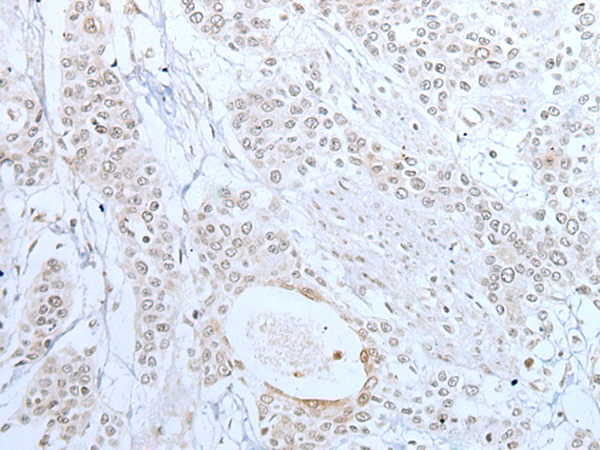

| WB | 咨询技术 | Human,Mouse,Rat |
| IF | 咨询技术 | Human,Mouse,Rat |
| IHC | 1/10-1/50 | Human,Mouse,Rat |
| ICC | 技术咨询 | Human,Mouse,Rat |
| FCM | 咨询技术 | Human,Mouse,Rat |
| Elisa | 1/5000-1/10000 | Human,Mouse,Rat |
| Aliases | BIRC4BP; XIAPAF1; HSXIAPAF1 |
| Host/Isotype | Rabbit IgG |
| Antibody Type | Primary antibody |
| Storage | Store at 4°C short term. Aliquot and store at -20°C long term. Avoid freeze/thaw cycles. |
| Species Reactivity | Human |
| Immunogen | Synthetic peptide of human XAF1 |
| Formulation | Purified antibody in PBS with 0.05% sodium azide and 50% glycerol. |
+ +
以下是关于XAF1抗体的3篇参考文献的简要整理:
---
1. **文献名称**:*"XAF1 is an antagonist of XIAP anti-apoptotic activity and enhances XIAP-mediated caspase-3 activation"*
**作者**:Liston P., et al.
**摘要**:该研究揭示了XAF1通过直接结合XIAP(X-linked inhibitor of apoptosis protein)拮抗其抗凋亡功能,促进胱天蛋白酶(caspase)活化,从而增强细胞凋亡,为癌症治疗提供了潜在靶点。
2. **文献名称**:*"Sensitization of cancer cells to TRAIL-induced apoptosis by the interferon-inducible gene XAF1"*
**作者**:Chawla-Sarkar M., et al.
**摘要**:研究发现干扰素(IFN)通过诱导XAF1表达,增强肿瘤坏死因子相关凋亡诱导配体(TRAIL)的促凋亡效应,揭示了XAF1在肿瘤细胞凋亡调控中的关键作用及其联合治疗潜力。
3. **文献名称**:*"Epigenetic silencing of XAF1 in colorectal cancer"*
**作者**:Byun D.S., et al.
**摘要**:该文献报道结直肠癌中XAF1基因因启动子区域高甲基化而表达下调,提示其作为肿瘤抑制因子的功能缺失可能促进肿瘤进展,为表观遗传治疗提供了依据。
---
**注**:以上文献信息基于领域内典型研究主题整理,实际引用时建议通过PubMed或Web of Science核对具体细节及最新进展。
XAF1 (XIAP-associated factor 1) is a tumor suppressor protein that interacts with X-linked inhibitor of apoptosis (XIAP), a key regulator of caspase activity and apoptosis. Discovered in 2000. XAF1 functions as a pro-apoptotic factor by counteracting XIAP's anti-apoptotic effects, promoting caspase activation and sensitizing cells to apoptotic stimuli. Its expression is often downregulated in various cancers due to epigenetic silencing (e.g., promoter hypermethylation) or genetic alterations, correlating with tumor progression, therapy resistance, and poor prognosis. XAF1 also exhibits antiviral properties by enhancing interferon signaling pathways.
XAF1 antibodies are essential tools for investigating its biological roles, including subcellular localization (nucleocytoplasmic shuttling), protein-protein interactions, and regulatory mechanisms in apoptosis and immune responses. Researchers utilize these antibodies in techniques like Western blotting, immunohistochemistry, and immunofluorescence to assess XAF1 expression patterns in normal tissues versus malignancies. In cancer research, XAF1 antibodies help evaluate its potential as a diagnostic/prognostic biomarker or therapeutic target, particularly in cancers like colorectal, gastric, and hepatocellular carcinomas where XAF1 dysregulation is prominent. Recent studies also explore its involvement in inflammatory diseases and viral infections, expanding its relevance beyond oncology.
×